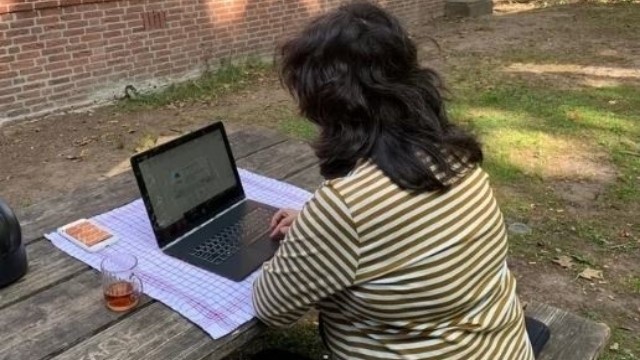Qelbinur Sidik, not showing her face for security reasons.
The CCP has shamelessly attacked the character of Uyghur women who have courageously testified to the rape and torture they endured or witnessed with their own eyes. Here is one.
Four years ago this week, as people around the world celebrated International Women’s Day, Ms. Qelbinur Sidik was assigned by Xinjiang authorities to work in a concentration camp. She had 28 years of teaching experience at the No. 24 Elementary School of Urumchi in East Turkistan. Chinese government officials told her she would be teaching Chinese language classes at a transformation through education camp for illiterate Uyghurs.
I interviewed Qelbinur for the Uyghur Human Rights Project in 2020, after she had reached safety in the Netherlands. It was a traumatic interview, reflecting the unutterable horrors she witnessed.
Qelbinur was shocked when she arrived at her new teaching assignment. The building was surrounded by high, barb-wired-topped walls, and fully armed security guards were posted at the gate and throughout the compound. She was escorted by the guards through security, checked in with her name and ID number, and taken to the multi-story building where “students” were kept. It was strange and bewildering to see these jail-like conditions. Her “classroom” was a big hall with hundreds of small chairs like preschoolers’, and its windows fitted with iron bars. There was one table, a mobile blackboard for the teacher, and cameras in all corners of the classroom.
Her second shock was seeing the students themselves, all men. Most appeared to be religious scholars and imams. They looked pale and exhausted, their hair overgrown and unkempt, their eyes sunken. It looked to her like they had faced some immense horror. They wore grey uniforms with an orange vest. Out of habit and respect for the elderly, she greeted them with the traditional “hello” in Uyghur: “Essalamueleykum.” They flinched in alarm. Here, the “students” were punished if they spoke in Uyghur, talked with a fellow student, or used another student’s name. Each vest had a number on the back, and they were to be called on by that number by the “teacher.”
Qelbinur’s first lesson was unbearable and unforgettable. As she wrote out Chinese characters on the board, she could hear a student weeping at the back. It felt sickening that she could not face her students and ask them what was wrong. She felt her throat tighten. Those first four hours stretched on forever. One day, a student asked her, in Uyghur, to please finish the lesson quickly so they could be released. She never saw that student again.
According to a police officer at the camp, students would “graduate” if they completed the designated Chinese lessons. She taught scholars who were far from “illiterate.” The rich businessmen detained in the camp required no job training. The elderly people who had already retired from work had no need for training of any kind.
Later, Qelbinur was moved to a concentration camp for women in Urumchi. It was just as prison, like as the camp for men. One her first day, she witnessed two guards carry a young Uyghur woman out of a building on a stretcher; she was dead.
The women’s camp was a six-story building. Each floor had around 20 cells, housing 20-30 detainees. The classroom on each floor was big and dark, with iron bars on the windows. It was filled with hundreds of small chairs, and there was a metal, cage-like box for the teacher, to isolate her from the students. Qelbinur could only see as far as the third row of students. The faces of the rest were in shadow due to the lack of light. All the women’s heads were shaved, and at first Qelbinur wondered whether they were women or young boys. All wore grey uniforms with numbered orange vests.
Here too, teaching was a heartbreaking experience. The students were silent, like muted dolls. Rows and rows of pale, skinny heads were all bowed down, as if they were connected to one another with an invisible rope, their fearful eyes testifying to their hellish experiences. Some days she noticed young girls unable to sit on the small chair, as if sitting were painful and standing were unbearable.
Qelbinur witnessed in real life what she had heard from a camp policewoman: the Chinese male guards and policemen love to work in female camps.
The female detainees faced systematic torture and rape, food deprivation, sleep deprivation, and strange injections—some bled to death after being administered unknown medicines. Many disappeared during Qelbinur’s time in the camp.
Qelbinur lost faith in humanity. She forgot about days and months, and her former life. Today, she is haunted by the faces and lifeless eyes of the helpless, brutalized victims.
Qelbinur has not celebrated anything like International Women’s Day since her time in the concentration camps. March 8 was simply another Genocide Day for Uyghur women in 2021, four years after her nightmare began.
The Chinese foreign ministry has shamelessly attacked the character of Uyghur women who have courageously testified to the rape and torture they endured or witnessed with their own eyes.
If the Chinese government truly has nothing to hide in our Uyghur homeland of East Turkistan, then international women’s rights groups, journalists, and an unfettered UN investigation would be welcomed. This has not happened.
The only meaningful International Women’s Day for Uyghurs will be the day the world takes action to end the nightmare of all Uyghur women—all those still lost in the camps, all those mourning the death and disappearance of loved ones, and all those living with unbearable memories.

